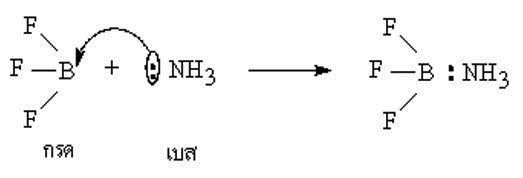การศึกษาแนวแนวคิดเรื่อง กรด–เบส ของนักเรียนชั้นมัธยมศึกษาปีที่ 5
Main Article Content
Abstract
Jinnipa Nakasenee, Pattamaporn Pimthong and Pornpun Pornsilapatip
รับบทความ: 5 มีนาคม 2558; ยอมรับตีพิมพ์: 18 พฤษภาคม 2558
บทคัดย่อ
จุดมุ่งหมายของงานวิจัยนี้คือเพื่อศึกษาแนวคิดเรื่อง กรด–เบส ของนักเรียนชั้นมัธยมศึกษาปีที่ 5 ของโรงเรียนมัธยมศึกษาขนาดใหญ่พิเศษแห่งหนึ่งในจังหวัดนนทบุรีจำนวน 48 คน เครื่องมือที่ใช้ในงานวิจัย ได้แก่ แบบวัดแนวคิดชนิดปลายเปิด ในหัวข้อสารละลายกรด–เบสและทฤษฎีกรด–เบส วิเคราะห์ข้อมูลโดยจัดกลุ่มแนวคิดของนักเรียนตามการจัดกลุ่มของ Andersson (1990) ผลการวิจัยพบว่า นักเรียนส่วนใหญ่ร้อยละ 46.51 ใช้องค์ประกอบของสารในการพิจารณาว่าสารชนิดใดเป็นกรด เช่น สารที่เป็นกรดคือสารที่มี H หรือ S เป็นองค์ประกอบ และนักเรียนร้อยละ 48.84 ใช้ประสบการณ์ในชีวิตประจำวันในการอธิบายความเป็นเบสของสาร เช่น เบสคือสารที่สัมผัสแล้วลื่น มีรสฝาด ไม่เปรี้ยวและไม่กัดกร่อน สำหรับหัวข้อทฤษฎีกรด–เบส แบ่งได้เป็น 3 ประเด็น คือ ทฤษฎีกรด–เบสของอาร์เรเนียส พบว่า นักเรียนส่วนใหญ่ร้อยละ 48.49 อธิบายว่ากรดคือสารที่แตกตัวได้ H+ และนักเรียนร้อยละ 42.43 อธิบายว่าเบสคือสารที่แตกตัวได้ OH– โดยส่วนมากไม่ได้กล่าวถึงน้ำซึ่งเป็นตัวทำละลาย สำหรับทฤษฎีกรด–เบสของเบรินเสตด–ลาวรี พบว่า นักเรียนส่วนใหญ่ร้อยละ 33.33 อธิบายความเป็นกรดของสารโดยใช้เหตุผลอื่น ๆ ที่ไม่เกี่ยว-ข้องกับทฤษฎีกรด–เบส เช่น อธิบายกว่ากรดคือสารที่มีประจุบวก กรดคือสารที่มี H มากกว่า และนักเรียนร้อยละ 33.33 อธิบายความเป็นเบสของสารว่า เบสคือสารที่มีประจุลบหรือเป็นสารที่ไม่นำไฟฟ้า และสำหรับทฤษฎีกรด–เบสของลิวอิส พบว่า นักเรียนส่วนใหญ่ร้อยละ 18.18 อธิบายว่า กรดคือสารที่รับอิเล็กตรอนจากสารอื่น และเบสคือสารที่ให้อิเล็กตรอนแก่สารอื่น
คำสำคัญ: แนวคิด กรด–เบส ทฤษฎีกรด–เบส
Abstract
The purpose of this study was to study forty eight Grade 11th students’ conceptions about acids and bases in a special large school of Nontaburi province. The research instrument was an open-ended concept survey about acids and bases and theories of acids and bases. The data were analyzed by categorizing into groups based on Andersson (1990). The result found that 46.51% of students identified acids by using the compositions of substance. For example, acid was included H and S. While 48.84% of students identified bases by relating to everyday life. For instance, base felt slippery, bitter, was not sour and corrosion. There were three theories of acid and base. Following the Arrhenius theory, most students (48.49%) explained that acids produced H+ while 42.43% of students explain that bases produced OH–. Most of them did not mention water as a solvent. Following the Brønsted–Lowry theory, most students (33.33%) gave other explanations which did not related to theories of acids and bases. For example, acids hold positive ion, acids had H more than bases. Other 33.33% of students gave similar explanations, for example, bases hold negative ion and base did not conduct electricity. For the Lewis theory, most students (18.18%) explained that acid was an electron acceptor and base was an electron donor.
Keywords: Concept, Acid-base, Acid-base theory
Downloads
Article Details

This work is licensed under a Creative Commons Attribution-NonCommercial 4.0 International License.
References
จิตตมาส สุขแสวง. (2549). การศึกษาแนวคิดของนักเรียน และพฤติกรรมการสอนของครูเรื่อง กรด–เบส ในระดับชั้นมัธยมศึกษาปีที่ 5 ของโรงเรียนแห่งหนึ่งในเขตจตุจักร กรุงเทพมหานคร. วิทยานิพนธ์ปริญญาศิลปศาสตรมหาบัณฑิต (ศึกษาศาสตร์-การสอน) สาขาการสอนวิทยาศาสตร์. กรุงเทพฯ: มหาวิทยาลัยเกษตรศาสตร์.
ประดับ นาคแก้ว. (2553). หนังสือเรียนวิทยาศาสตร์ ระดับชั้นมัธยมศึกษาปีที่ 1. กรุงเทพฯ: แม๊ค.
ชาตรี ฝ่ายคำตา. (2554). วิธีสอนวิทยาศาสตร์ระดับประถมศึกษา. กรุงเทพฯ: เอพริลเรนพริ้นติ้ง.
ภพ เลาหไพบูลย์. (2534). แนวการสอนวิทยาศาสตร์. กรุงเทพฯ: ไทยวัฒนาพานิช.
สถาบันส่งเสริมการสอนวิทยาศาสตร์และเทคโนโลยี [สสวท.]. (2554). หนังสือเรียนรายวิชาเพิ่มเติม เคมี เล่ม 3 ชั้นมัธยมศึกษาปีที่ 4-6. กรุงเทพฯ: โรงพิมพ์ สกสค. ลาดพร้าว.
สุภาพร อินบุญนะ.(2541). มโนมติที่คลาดเคลื่อนเรื่อง กรด–เบส ของนักเรียนชั้นมัธยมศึกษาตอนปลาย จังหวัดนครศรีธรรมราช. วิทยานิพนธ์ปริญญาศึกษาศาสตร์มหาบัณฑิต สาขาวิทยาศาสตร์ศึกษา. มหาวิทยาลัยสงขลานครินทร์.
สุวิมล เขี้ยวแก้ว. (2540). การสอนวิทยาศาสตร์ระดับมัธยมศึกษา. ภาควิชาการศึกษา คณะศึกษาศาสตร์. ปัตตานี: มหาวิทยาลัย สงขลานครินทร์.
สำนักวิชาการและมาตรฐานการศึกษา. (2552). ตัวชี้วัดและสาระการเรียนรู้แกนกลางกลุ่มสาระการเรียนรู้ วิทยาศาสตร์ตามหลักสูตรแกนกลาง การศึกษาขั้นพื้นฐาน พุทธศักราช 2551. กรุงเทพฯ: โรงพิมพ์ชุมชนสหกรณ์การเกษตรแห่งประเทศ.
Andersson, B. (1990). Pupils’ conceptions of matter and its transformations (age 12–16). Studies in Science Education 18(1): 53–58.
Cetingul, P. I., and Geban, O. (2005).Under-standing of acid-base concept by using conceptual change approach. H. U. Journal of Education 29: 69–74.
Demircioglu, G., Ayas, A., and Demircioglu, H. (2005).Conceptual change achieved through a new teaching program on acids and bases. Chemistry Education Re-search and Practice 6(1): 36–51.
Nieswandt, M. (2001). Problems and possibilities for learning in an introductory chemistry course from a conceptual change perspective. Science Education 85: 158–179.
Tyson, L. M., Venville, G. J., Harrison, A. G., and Treagust, D. F. (1997). A multidimensional framework for interpreting conceptual change events in the classroom. Science Education 81: 387–404.
